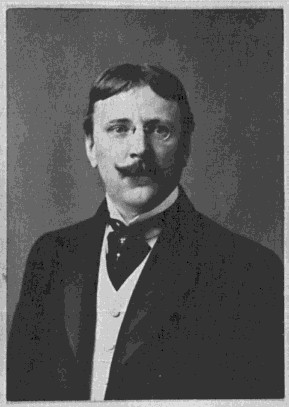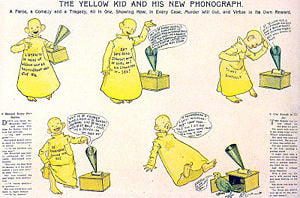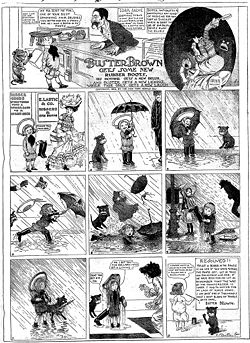Outcault, Richard Felton
John Parker (talk | contribs) m (→Legacy) |
John Parker (talk | contribs) m |
||
| Line 21: | Line 21: | ||
facilities. | facilities. | ||
| − | as humoristic sketcher for the magazines ''Judge'' and ''Life'', but soon joined [[Joseph Pulitzer|Joseph Pulitzer's]] ''[[New York World]]''. Pulitzer used Outcault's comics in an experimental color supplement, using a single-panel color cartoon on the front page called ''Hogan's Alley,'' depicting an event in a fictional slum. A character in the panel, The Yellow Kid, | + | as humoristic sketcher for the magazines ''Judge'' and ''Life'', but soon joined [[Joseph Pulitzer|Joseph Pulitzer's]] ''[[New York World]]''. Pulitzer used Outcault's comics in an experimental color supplement, using a single-panel color cartoon on the front page called ''Hogan's Alley,'' depicting an event in a fictional slum, was based on life in New York City. A character in the panel, The Yellow Kid, was a kid named Mickey Dugan, living in the street, whose oversize frock always had some kind of saying written on it. ''Hogan's Alley'' debuted May 5, 1895. The color yellow was picked because it was difficult to print at the time, yet Outcault wanted to try yellow on the kid's frock. Average readers loved the cartoon, but the comic strip was not without controversy. New York elites were upset about the depiction of New York City slums in ''Hogan's Alley''. The Yellow Kid gave rise to the phrase "[[yellow journalism]]," which described the sensational journalism of the day |
| + | In October 1896, Outcault defected to [[William Randolph Hearst|William Randolph Hearst's]] ''[[New York Journal]]''. The result of a lawsuit awarded the title "Hogan's Alley" to the ''World'' and "The Yellow Kid" to the ''Journal''. | ||
| − | + | By 1901 Outcault had become weary of legal battles and created the comic strip ''Poor L'L Mose'' for the ''New York Herald''. | |
| − | In 1902, Outcault introduced [[Buster Brown]], a mischievous boy dressed in Little Lord Fauntleroy style, and his dog Tige. The strip and characters were very popular and Outcault eventually licensed the name for a number of consumer products, most notably Buster Brown shoes. | + | In 1902, Outcault introduced [[Buster Brown]], a mischievous boy dressed in Little Lord Fauntleroy style, and his dog Tige. The Buster Brown comic was featured weekly every Sunday until 1920 in the ''New York Journal''.in the The strip and characters were very popular and Outcault eventually licensed the name for a number of consumer products, most notably Buster Brown shoes. |
[[Image:Buster Brown rubber boots.jpg|thumb|right|250 px| Buster Brown]] | [[Image:Buster Brown rubber boots.jpg|thumb|right|250 px| Buster Brown]] | ||
In the ''Journal,'' Outcault began experimenting with using multiple panels and speech balloons. Although he was not the first to use either technique, his use of them created the standard by which comics were measured. | In the ''Journal,'' Outcault began experimenting with using multiple panels and speech balloons. Although he was not the first to use either technique, his use of them created the standard by which comics were measured. | ||
| + | |||
| + | In 1909 Outcault partnered with his son to create the Outcault Advertising Agency. | ||
==Legacy== | ==Legacy== | ||
| − | Ricahrd Felton Outcault was a | + | Ricahrd Felton Outcault was a gifted artist, painter, and sketcher, who combined his talents to become the inventor of the modern comic strip. Outcault created two of the most popular comic strip characters, The Yellow Kid, and Buster Brown. the Yellow Kid appeared in 2 New York papers from 1895-1989, and was incredibly successful.There were even lines of toys and products developed as a result. In 1902, Outcault created Buster Brown, a cartoon about a rich yet mischevious boy and his bulldog Tige. The bulldog in the cartoon was created out of the likeness of Outcault's pet bulldog. The were so popular that they also spawned many associated products. In 1904 Outcault sold the license for Buster and Tige to the Buster Brown Shoes company, which became a very popular brand. Outcault's cartoon genius led to the birth and development of comic strips, which have and continue to influence our culture. |
==Publications== | ==Publications== | ||
Revision as of 01:17, 9 December 2007
Richard Felton Outcault (January 14, 1863-September 25, 1928) was an American comic strip scriptwriter, sketcher and painter in the early 20th century. Popularly known as R.F. Outcault, he is considered the inventor of the modern comic strip and credited for making comic strips part of American society. Starting out as a technical illustrator for Thomas Edison, Outcault wrote articles for humor magazines, which spawned his career in creating comic strips. His genius was demonstrated through 2 popular cartoons, The Yellow Kid and Buster Brown. These popular cartoon characters led to a line of products, toys, and even shoes (Buster Brown).
Life
Richard Felton Outcault was born on January 14, 1863 in Lancaster, Ohio, the son of Jesse and Catherine Outcault. He demonstrated artistic talent at a young age, and in 1878 at only fifteen years of age, he began studying art at the School of Design at McMicken University in Cincinnati, Ohio.
He died on September 25th, 1928 in Flushing, New York.
Work
Outcault began his career in 1881 as a painter for the Hall Safe and Lock Company. In 1888, Thomas Edison hired Outcault to produce sophisticated tehnical illustrations for the Edison Laboratories this electric light display fof the Exposition of the Ohio Valley and Middle Atlantic States in Cincinnati, Ohio. Edison was so impressed with the quality of Outcault's work, that Edison hired him to work in his West Orange, New Jersey facilities.
as humoristic sketcher for the magazines Judge and Life, but soon joined Joseph Pulitzer's New York World. Pulitzer used Outcault's comics in an experimental color supplement, using a single-panel color cartoon on the front page called Hogan's Alley, depicting an event in a fictional slum, was based on life in New York City. A character in the panel, The Yellow Kid, was a kid named Mickey Dugan, living in the street, whose oversize frock always had some kind of saying written on it. Hogan's Alley debuted May 5, 1895. The color yellow was picked because it was difficult to print at the time, yet Outcault wanted to try yellow on the kid's frock. Average readers loved the cartoon, but the comic strip was not without controversy. New York elites were upset about the depiction of New York City slums in Hogan's Alley. The Yellow Kid gave rise to the phrase "yellow journalism," which described the sensational journalism of the day
In October 1896, Outcault defected to William Randolph Hearst's New York Journal. The result of a lawsuit awarded the title "Hogan's Alley" to the World and "The Yellow Kid" to the Journal.
By 1901 Outcault had become weary of legal battles and created the comic strip Poor L'L Mose for the New York Herald.
In 1902, Outcault introduced Buster Brown, a mischievous boy dressed in Little Lord Fauntleroy style, and his dog Tige. The Buster Brown comic was featured weekly every Sunday until 1920 in the New York Journal.in the The strip and characters were very popular and Outcault eventually licensed the name for a number of consumer products, most notably Buster Brown shoes.
In the Journal, Outcault began experimenting with using multiple panels and speech balloons. Although he was not the first to use either technique, his use of them created the standard by which comics were measured.
In 1909 Outcault partnered with his son to create the Outcault Advertising Agency.
Legacy
Ricahrd Felton Outcault was a gifted artist, painter, and sketcher, who combined his talents to become the inventor of the modern comic strip. Outcault created two of the most popular comic strip characters, The Yellow Kid, and Buster Brown. the Yellow Kid appeared in 2 New York papers from 1895-1989, and was incredibly successful.There were even lines of toys and products developed as a result. In 1902, Outcault created Buster Brown, a cartoon about a rich yet mischevious boy and his bulldog Tige. The bulldog in the cartoon was created out of the likeness of Outcault's pet bulldog. The were so popular that they also spawned many associated products. In 1904 Outcault sold the license for Buster and Tige to the Buster Brown Shoes company, which became a very popular brand. Outcault's cartoon genius led to the birth and development of comic strips, which have and continue to influence our culture.
Publications
- Outcault, Richard Felton.1995.R.F. Outcault's the Yellow Kid: A Centennial Celebration of the Kid Who Started the Comics. Kitchen Sink Press. ISBN 0878163794 ISBN 978-0878163793
- Outcault, Richard Felton.1977.Buster Brown: An Original Compilation, First Collection in Full Continuity of a Complete Year from the Sunday Strip.Hyperion Pr. ISBN 088355660X ISBN 978-0883556603.
ReferencesISBN links support NWE through referral fees
- Campbell, W. Joseph. 2003. Yellow Journalism: Puncturing the Myths, Defining the Legacies. Praeger Paperback. ISBN 0275981134
- Who2 biography of R.F. Outcault [1]
External links
Credits
New World Encyclopedia writers and editors rewrote and completed the Wikipedia article in accordance with New World Encyclopedia standards. This article abides by terms of the Creative Commons CC-by-sa 3.0 License (CC-by-sa), which may be used and disseminated with proper attribution. Credit is due under the terms of this license that can reference both the New World Encyclopedia contributors and the selfless volunteer contributors of the Wikimedia Foundation. To cite this article click here for a list of acceptable citing formats.The history of earlier contributions by wikipedians is accessible to researchers here:
The history of this article since it was imported to New World Encyclopedia:
Note: Some restrictions may apply to use of individual images which are separately licensed.


